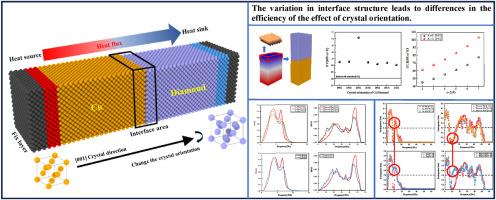Investigation of the effect of crystal orientation on phonon thermal transport at the Cu/diamond interface by molecular dynamics
IF 5
2区 工程技术
Q1 ENGINEERING, MECHANICAL
International Journal of Thermal Sciences
Pub Date : 2025-09-02
DOI:10.1016/j.ijthermalsci.2025.110271
引用次数: 0
Abstract
Optimizing thermal transport across metal/semiconductor interfaces is crucial for developing next-generation thermal management solutions. This investigation employs non-equilibrium molecular dynamics (NEMD) simulations to quantify the crystallographic orientation effects on interfacial thermal conductance (ITC) at Cu/diamond interfaces with distinct surface morphologies. The results show that the effect of crystal orientation on the ITC of Cu/diamond is non-negligible. There is a difference in the effect of crystal orientation on ITC for flat and rough interface structures. The ITC of the Cu/diamond interface with the crystal orientation of [2 0 1] for the flat interface structure is 50.87 MW/m2-K, which is a 2.48-fold growth rate compared to the [0 0 1] crystal orientation. The analysis of the phonon density of states (PDOS) and phonon participation ratio (PR) reveals that the observed increase in ITC is attributed to the enhancement of phonon vibrational coupling at the interface and the improvement of the phonon localization phenomenon in the low-frequency region. The enhancement of [2 0 1] crystal orientation in ITC of Cu/diamond is less effective when the interface structure is rough. This is due to the fact that it is less effective in enhancing the phonon vibrational coupling and doesn't improve the phonon localization in the low-frequency region. These results establish crystallographic orientation engineering as a viable strategy for composite thermal conductivity enhancement, offering performance comparable to advanced material modification techniques while preserving interfacial integrity.

晶体取向对Cu/金刚石界面声子热输运影响的分子动力学研究
优化金属/半导体界面的热传输对于开发下一代热管理解决方案至关重要。本研究采用非平衡分子动力学(NEMD)模拟来量化具有不同表面形貌的Cu/金刚石界面上的晶体取向对界面热导率(ITC)的影响。结果表明,晶体取向对铜/金刚石的ITC的影响是不可忽略的。对于平面和粗糙的界面结构,晶体取向对ITC的影响是不同的。晶体取向为[2 0 1]的Cu/金刚石界面在平面界面结构下的ITC为50.87 MW/m2-K,是晶体取向为[0 0 1]的2.48倍。声子态密度(PDOS)和声子参与比(PR)的分析表明,ITC的增加是由于界面声子振动耦合的增强和低频区声子局域化现象的改善。当界面结构较粗糙时,Cu/金刚石的ITC中[21 1]晶向的增强效果较差。这是由于它在增强声子振动耦合方面效果较差,并且不能改善低频区域声子的局部化。这些结果表明,晶体取向工程是增强复合材料导热性的可行策略,在保持界面完整性的同时,提供与先进材料改性技术相当的性能。
本文章由计算机程序翻译,如有差异,请以英文原文为准。
求助全文
约1分钟内获得全文
求助全文
来源期刊

International Journal of Thermal Sciences
工程技术-工程:机械
CiteScore
8.10
自引率
11.10%
发文量
531
审稿时长
55 days
期刊介绍:
The International Journal of Thermal Sciences is a journal devoted to the publication of fundamental studies on the physics of transfer processes in general, with an emphasis on thermal aspects and also applied research on various processes, energy systems and the environment. Articles are published in English and French, and are subject to peer review.
The fundamental subjects considered within the scope of the journal are:
* Heat and relevant mass transfer at all scales (nano, micro and macro) and in all types of material (heterogeneous, composites, biological,...) and fluid flow
* Forced, natural or mixed convection in reactive or non-reactive media
* Single or multi–phase fluid flow with or without phase change
* Near–and far–field radiative heat transfer
* Combined modes of heat transfer in complex systems (for example, plasmas, biological, geological,...)
* Multiscale modelling
The applied research topics include:
* Heat exchangers, heat pipes, cooling processes
* Transport phenomena taking place in industrial processes (chemical, food and agricultural, metallurgical, space and aeronautical, automobile industries)
* Nano–and micro–technology for energy, space, biosystems and devices
* Heat transport analysis in advanced systems
* Impact of energy–related processes on environment, and emerging energy systems
The study of thermophysical properties of materials and fluids, thermal measurement techniques, inverse methods, and the developments of experimental methods are within the scope of the International Journal of Thermal Sciences which also covers the modelling, and numerical methods applied to thermal transfer.
 求助内容:
求助内容: 应助结果提醒方式:
应助结果提醒方式:


